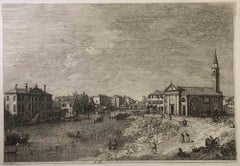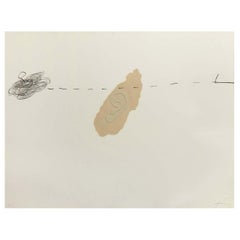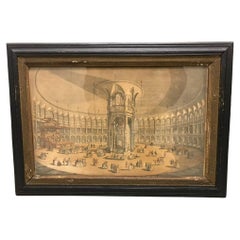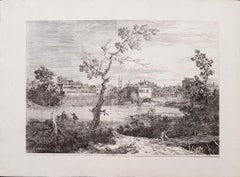Giovanni Antonio Canal (Canaletto) Art
to
1
1
2
2
1
1
Al Dolo - Etching by Giovanni Antonio Canal - 1735/44
By Giovanni Antonio Canal (Canaletto)
Located in Roma, IT
Al Dolo is an original Artwork realized by Giovanni Antonio Canal, commonly known as Canaletto (Venice, 1697 - 1768).
Original Etching on Laid paper...
Category
1730s Modern Giovanni Antonio Canal (Canaletto) Art
Materials
Etching
Giovanni Antonio Canal 'Canaletto' Etching of Prato Della, Venice, 1697-1768
By Giovanni Antonio Canal (Canaletto)
Located in Oklahoma City, OK
Lovely etching on paper in back ink by Giovanni Antonio Canal (Canaletto).
Measurements:
22" x 15"
Hand-numbered in pencil at the bottom right with the number 6.
Part of a co...
Category
18th Century Italian Rococo Antique Giovanni Antonio Canal (Canaletto) Art
Materials
Paper
Related Items
Antoni Tàpies Etching, Orella, 1971
By Antoni Tàpies
Located in Barcelona, Barcelona
Orella etching made by Antoni Tapies in Barcelona in 1971
Edition 75
Measures: 60 x 78 cm.
In good original condition. Numbered and hand signed, edition of 75
We have sever...
Category
1970s Spanish Modern Vintage Giovanni Antonio Canal (Canaletto) Art
Materials
Paper
18th C Hand Colored Engraving of The Rotunda at Ranleagh Gardens After Canaletto
By Giovanni Antonio Canal (Canaletto)
Located in Stamford, CT
An inside View of the Rotundo in Ranelagh Gardens, after Antonio Canaletto (1697 - 1768). Engraved by by Thomas Bowles, 1754.
Hand colored engraving, in original ebonized frame with...
Category
Mid-18th Century English George II Antique Giovanni Antonio Canal (Canaletto) Art
Materials
Paper
H 13.5 in W 19.5 in D 1 in
Pair of Original Antique French Triumph Etchings
Located in Chicago, IL
Original antique French etchings in their original gilt frames that would be awesome used in most any room of the home.
Category
19th Century French Antique Giovanni Antonio Canal (Canaletto) Art
Materials
Paper
Comanche Dance, Ildefonso Pueblo, New Mexico Southwest Framed Etching
By Gene Kloss
Located in Denver, CO
Comanche Dance at San Ildefonso Pueblo (New Mexico). Etching and drypoint, artist's proof from an edition of 50 prints. Presented in a custom frame, outer dimensions measure 22 ¼ x 18 ½ x ½ inches. Image size is 11 ¾ x 14 ½ inches.
Print is clean and in very good vintage condition - please contact us for a detailed condition report.
Expedited and international shipping is available - please contact us for a quote.
About the Artist:
Gene (Alice Geneva) Kloss is considered one of America’s master printmakers. She was born in Oakland, California and established herself as an artist on the West coast.
Kloss was introduced to etching by Perham Nahl while at UC Berkley. She graduated in 1924, and in 1925 married poet Phillips Kloss. In her late twenties, Kloss moved to Taos, New Mexico and began her life’s work of the New Mexican landscape and peoples. It was at this time that she received national acclaim.
Her artwork exudes an unmistakable content and style. Enchanted by the architecture, mountainous landscapes and rituals of the inhabitants, Kloss captured the beauty of the Southwest and surrounding areas. Her style was bold yet deftly simple, masterfully expressing the elusive Southwestern light...
Category
1980s American Modern Giovanni Antonio Canal (Canaletto) Art
Materials
Drypoint, Etching
H 22.25 in W 18.5 in D 0.5 in
The Gargoyle and His Quarry
By John Taylor Arms
Located in Storrs, CT
The Gargoyle and His Quarry, Notre Dame. 1920. Etching.Fletcher 90. 7 1/8 x 5 1/4 (sheet 10 1/2 x 9 1/16). Gargoyle series #1. Edition 75. A rich impression printed on 'FJHead&Co' c...
Category
1920s American Modern Giovanni Antonio Canal (Canaletto) Art
Materials
Drypoint, Etching
"The Caissons Go Rolling Along".
By Kerr Eby
Located in Storrs, CT
"The Caissons Go Rolling Along". 1929. Etching and sandpaper ground. Giardina 145. 17 3/8 x 9 1/2 (sheet 18 3/4 x 11 1/2). Edition 90. Slight mat line, otherwise find condition. A ri...
Category
1920s American Modern Giovanni Antonio Canal (Canaletto) Art
Materials
Drypoint, Etching
The Biggest of All; Telephone and Telegraph Building.
By Joseph Pennell
Located in Storrs, CT
The Biggest of All; Telephone and Telegraph Building. 1925. Etching. Wuerth 853. 9 7/8 x 11 7/8 (sheet 11 1/2 x 17 1/8). Edition probably 35. An atmospheric impression with plate tone, printed on antique laid paper...
Category
Early 20th Century American Modern Giovanni Antonio Canal (Canaletto) Art
Materials
Etching, Drypoint
H 9.88 in W 7.88 in D 0.5 in
From Knoedler's Window MCMXXXV
By John Taylor Arms
Located in Storrs, CT
From Knoedler's Window MCMXXV. 1935. Etching and Aquatint. Fletcher catalog 293 stateiv/v. Image: 5 1/16 x 4 15/16 (sheet 12/7/8 x 9 1/8). Edition 271 in this state (total edition 3...
Category
1920s American Modern Giovanni Antonio Canal (Canaletto) Art
Materials
Aquatint, Etching
Large Framed Etching of Versailles – Vue Particulière de la Chapelle du Château
Located in Montreal, Quebec
Large framed French Etching of Versailles – Vue Particulière de la Chapelle du Château de Versailles
Pair available on the Versailles Theme. From Mis en Demeure, Paris.
Category
Late 20th Century French Louis XVI Giovanni Antonio Canal (Canaletto) Art
Materials
Wood, Paper
H 23.75 in W 31.5 in D 0.75 in
The Gothic Spirit
By John Taylor Arms
Located in Storrs, CT
The Gothic Spirit (also called A Gargoyle, A Gothic Spirit). 1922. Etching and stipple. Fletcher 120. 11 5/8 x 7 (sheet 15 1/4 x 11 1/4). Gargoyle Series #8. Edition 130. Illustrated...
Category
1920s American Modern Giovanni Antonio Canal (Canaletto) Art
Materials
Drypoint, Etching
Alington in Wiltshire (The First Swallow).
By Robin Tanner
Located in Storrs, CT
Alington in Wiltshire (The First Swallow). 1927. Etching. Garton 2.iv. 6 3/4 x 8 7/8 (sheet 10 1/2 x 13 1/2). Final state published by in an editon of 12 by Garton & Cooke in 1982 (Nicolson published an edition of 40 in 1927). In states iii and iv, the swallow of the title was removed. In state iv, the sky was re-etched and the cross-hatching was slightly finer. Signed in pencil.
Garton writes, page 11: "The design was based on the Anglican chapel-of-ease is the farmyard of Bulisge at Allinston near Chippenham....The print was originally entitled The First Swallow, but the swallow was burnished out before the 1927 edition....Fifty years later new work was effected in the worn-out areas of the sky and distance to produce prints which, in his opinion, were better than those of the original edition."
Robin Tanner was an English artist, etcher, and printmaker. He followed the visionary tradition of Samuel Palmer and English neo-romanticism. His etchings began following night-school classes at Goldsmiths College, London. He had been inspired by the major Samuel Palmer retrospective exhibition organized by Martin Hardie...
Category
1920s Modern Giovanni Antonio Canal (Canaletto) Art
Materials
Etching
James Jacques Joseph Tissot "Soirée d'été" 'Summer Evening' Etching & Dry Point
By James Tissot
Located in Los Angeles, CA
A fine French 19th century etching and drypoint Titled "Soirée d'été" (Summer Evening) by Jacques Joseph Tissot (French, 1836-1902) depicting Mrs. Kathleen Newton resting on a lounge chair. Signed and dated (l/l): J.J. Tissot, 1881 in the plate. Under the mat, the front of the sheet inscribed in pencil with a '1' in a circle, the verso of the sheet with old price inscription "450-" in pencil. Circa: 1881-1882.
Measures: Plate Height: 9 inches (22.9 cm)
Plate Width: 15 1/2 inches (39.4 cm)
Sheet Height: 14 1/2 inches (36.8 cm)
Sheet Width: 20 5/8 inches (52.4 cm)
Frame Height: 19 inches (48.3 cm)
Frame Width: 24 1/2 inches (62.2 cm)
Frame Depth: 1 1/8 inches (2.9 cm)
Literature:
Wentworth 56. Note: Tissot's from 1881 is said to depict his lover, the Irish divorcee Mrs. Kathleen Newton, resting on a lounge chair.
Provenance:
Private collection, Los Angeles, California
Jacques Joseph Tissot (French, 15 October 1836 – 8 August 1902), Anglicized as James Tissot, was a French painter and illustrator. He was a successful painter of Paris society before moving to London in 1871. He became famous as a genre painter of fashionably dressed women shown in various scenes of everyday life. He also painted scenes and characters from the Bible.
Jacques Tissot was born in the city of Nantes in France and spent his early childhood there. His father, Marcel Théodore Tissot, was a successful drapery merchant. His mother, Marie Durand, assisted her husband in the family business and designed hats. A devout Catholic, Tissot's mother instilled pious devotion in the future artist from a very young age. Tissot's youth spent in Nantes likely contributed to his frequent depiction of shipping vessels and boats in his later works. The involvement of his parents in the fashion industry is believed to have been an influence on his painting style, as he depicted women's clothing in fine detail. By the time Tissot was 17, he knew he wanted to pursue painting as a career. His father opposed this, preferring his son to follow a business profession, but the young Tissot gained his mother's support for his chosen vocation. Around this time, he began using the given name of James. By 1854 he was commonly known as James Tissot; he may have adopted it because of his increasing interest in everything English.
In 1856 or 1857, Tissot travelled to Paris to pursue an education in art. While staying with a friend of his mother, painter Elie Delaunay, Tissot enrolled at the Ecole des Beaux-Arts to study in the studios of Hippolyte Flandrin and Louis Lamothe. Both were successful Lyonnaise painters who moved to Paris to study under Jean-Auguste-Dominique Ingres. Lamothe provided the majority of Tissot's studio education, and the young artist studied on his own by copying works at the Louvre, as did most other artists of the time in their early years. Around this time, Tissot also made the acquaintance of the American James McNeill Whistler, and French painters Edgar Degas (who had also been a student of Lamothe and a friend of Delaunay), and Édouard Manet.
In 1859, Tissot exhibited in the Paris Salon for the first time. He showed five paintings of scenes from the Middle Ages, many depicting scenes from Goethe's Faust. These works show the influence in his work of the Belgian painter Henri Leys (Jan August Hendrik Leys), whom Tissot had met in Antwerp earlier that same year. Other influences include the works of the German painters Peter Von Cornelius and Moritz Retzsch. After Tissot had first exhibited at the Salon and before he had been awarded a medal, the French government paid 5,000 francs for his depiction of The Meeting of Faust and Marguerite in 1860, with the painting being exhibited at the Salon the following year, together with a portrait and other paintings.
Émile Péreire supplied Tissot's painting Walk in the Snow for the 1862 international exhibition in London; the next year three paintings by Tissot were displayed at the London gallery of Ernest Gambart.
In about 1863, Tissot suddenly shifted his focus from the medieval style to the depiction of modern life through portraits. During this period, Tissot gained high critical acclaim, and quickly became a success as an artist. Like contemporaries such as Alfred Stevens and Claude Monet, Tissot also explored Japonisme, including Japanese objects and costumes in his pictures and expressing style influence. Degas painted a portrait of Tissot from these years (Metropolitan Museum of Art, New York), in which he is sitting below a Japanese screen hanging on the wall.
Still on Top, 1873
Tissot fought in the Franco-Prussian War as part of the improvised defense of Paris, joining two companies of the Garde Nationale and later as part of the Paris Commune. His 1870 painting La Partie Carrée (The Foursome) evoked the period of the French revolution. Either because of the radical political associations related to the Paris Commune (which he was believed to have joined mostly to protect his own belongings rather than for shared ideology), or because of better opportunities, he left Paris for London in 1871. During this period, Seymour Haden helped him to learn etching techniques. Having already worked as a caricaturist for Thomas Gibson Bowles, the owner of the magazine Vanity Fair, as well as exhibited at the Royal Academy, Tissot arrived with established social and artistic connections in London. Tissot used...
Category
Late 19th Century French Victorian Antique Giovanni Antonio Canal (Canaletto) Art
Materials
Glass, Wood, Paper
H 19 in W 24.5 in D 1.13 in
Previously Available Items
Oil Painting Studio Canaletto: Neoclassical Scene with Architectural Ruins
By Giovanni Antonio Canal (Canaletto)
Located in London, GB
Studio of Giovanni Antonio Canal, called Il CANALETTO (Venice 1697 – 1768)
An Architectural Capriccio with figures amongst ruins
oil on canvas
88 x 92 cm. (34⅝ x 36¼ in.)
Provenan...
Category
1740s Rococo Giovanni Antonio Canal (Canaletto) Art
Materials
Oil
View of a Town on a River Bank - Original Etching by Canaletto
By Giovanni Antonio Canal (Canaletto)
Located in Roma, IT
Superb black and white etching with fresh impression, wide margins, printed on laid paper. An inscription at the lower center reads: “A. Canal f.”; at the lower right: “E 5”. Bromberg Second state on two, Montecuccoli, Third state on three.
In excellent conditions, except for some very light traces of oxidation and some ripples on the lower left corner. A wonderful etching of a view of a town on a river bank. On the farther bank of the river, there are some houses and a water mill. In the foreground, on the right, there is a wooden plank bridge and a man. On the left, by the river, there is a group of figures with a mule.
Antonio Canaletto...
Category
17th Century Old Masters Giovanni Antonio Canal (Canaletto) Art
Materials
Etching
H 15.36 in W 21.19 in D 0.04 in
Giovanni Antonio Canal (canaletto) art for sale on 1stDibs.
Find a wide variety of authentic Giovanni Antonio Canal (Canaletto) art available for sale on 1stDibs. You can also browse by medium to find art by Giovanni Antonio Canal (Canaletto) in etching and more. Much of the original work by this artist or collective was created during the 18th century and is mostly associated with the modern style. Not every interior allows for large Giovanni Antonio Canal (Canaletto) art, so small editions measuring 18 inches across are available. Customers who are interested in this artist might also find the work of Giuseppe Vasi, Antonio Donghi, and Giorgio Morandi. Giovanni Antonio Canal (Canaletto) art prices can differ depending upon medium, time period and other attributes. On 1stDibs, the price for these items starts at $33,422 and tops out at $33,422, while the average work can sell for $33,422.





